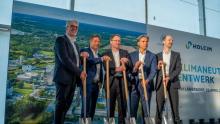Building materials provider
The recognition comes from non-governmental organisation CDP (formerly Carbon Disclosure Project). CDP’s scoring system assesses whether companies have formulated a coherent strategy on how to further improve their own environmental performance as well as that of customers and suppliers.
thyssenkrupp says that it has again achieved the highest score possible and was placed on CDP’s global “A List”. The list includes around 130 businesses worldwide.
Several thousand companies worldwide took part in the programme, which CDP conducts on behalf of more than 650 institutional investors with assets worth almost US$90 trillion. The organisation holds the world’s largest collection of corporate climate data and is regarded a benchmark in the capital markets.
In terms of climate protection, thyssenkrupp says it is focusing on continuous efficiency improvements and long-term innovation leaps – both for its customers and its own processes. "Despite the major global challenges, we are optimistic. With our resource-saving products and processes, we see climate change as an opportunity and are making our contribution to achieving the climate targets," said Reinhold Achatz, chief technology officer at thyssenkrupp.
The company gives the example of Oxyfuel, a solution it has developed which efficiently captures CO2 during cement production.
Another example is in steel production, where thyssenkrupp is pursuing a two-pillar strategy to achieve a sustained reduction in emissions - the utilisation of greenhouse gases generated during production and strategies for their avoidance. "On the one hand, we are focusing on the Carbon2Chem project, with which we can convert production gases into fuels such as methanol, for example," Achatz added. "We have already made good progress here.
"The next step is the large-scale expansion of the already proven technology. At the same time, we are working on a conversion to hydrogen-based steel production. We are convinced that there will not be just one technology. This is why we are open to new technologies and pursue different routes.”







